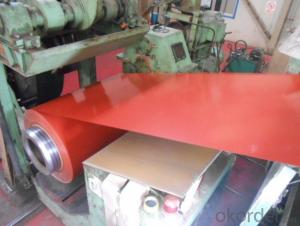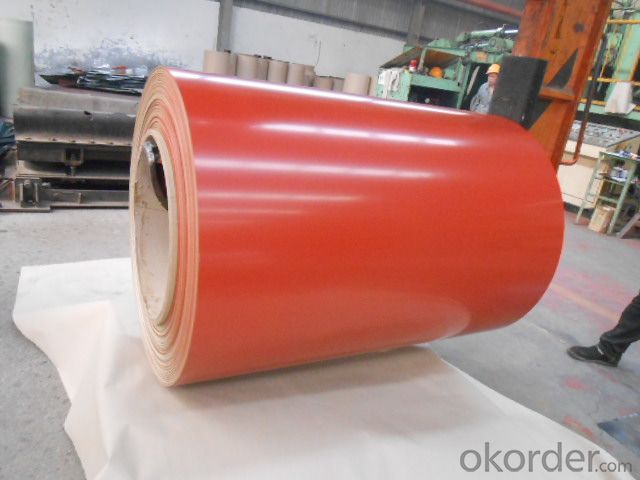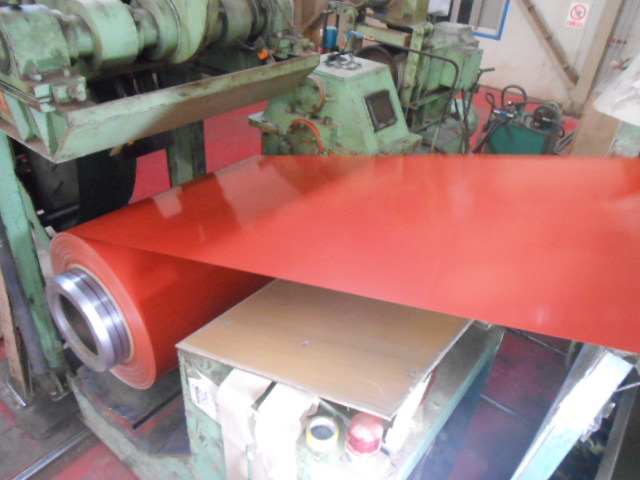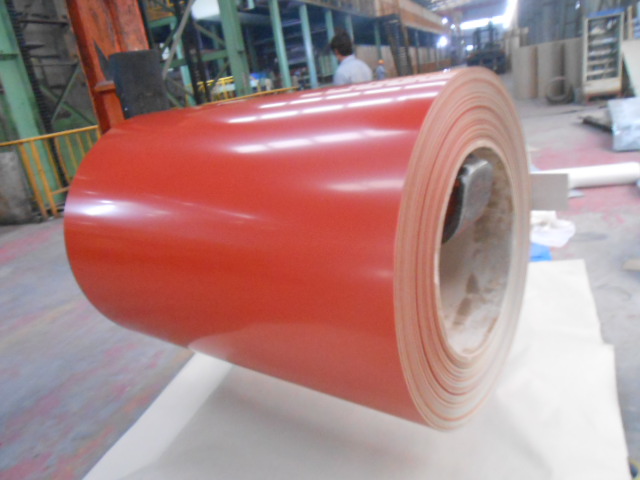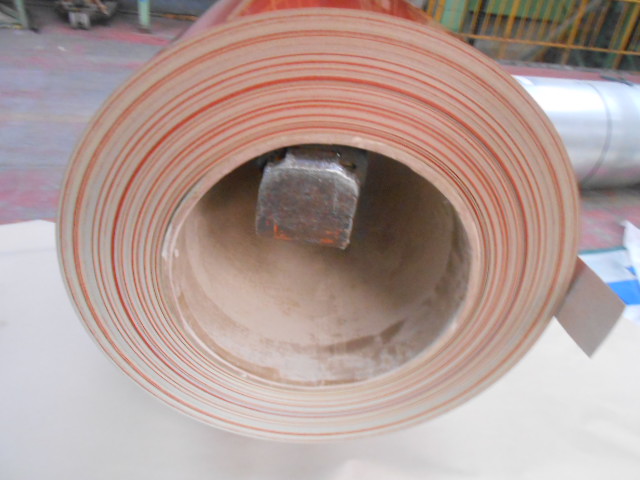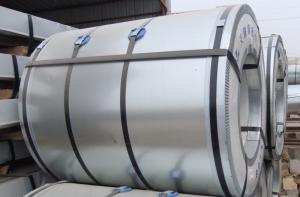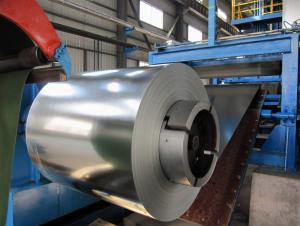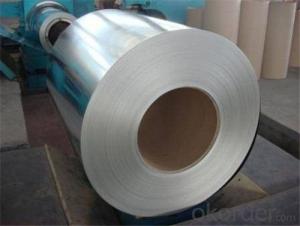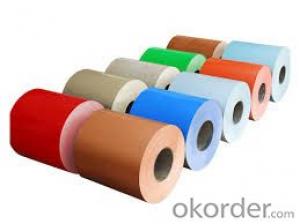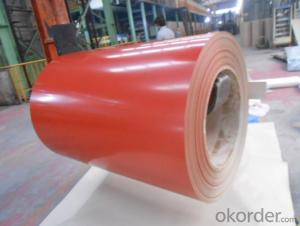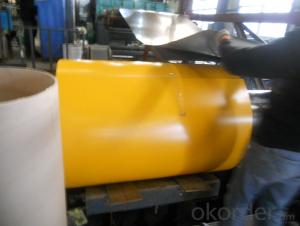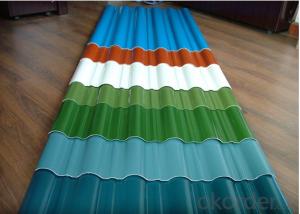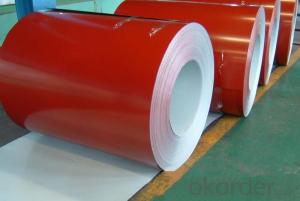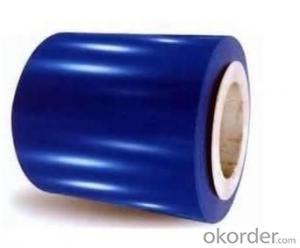Pre-Painted Galvanized Steel---Brick Red
- Loading Port:
- Tianjin
- Payment Terms:
- TT OR LC
- Min Order Qty:
- 100 m.t.
- Supply Capability:
- 10000 m.t./month
OKorder Service Pledge
OKorder Financial Service
You Might Also Like
1. Pre-Painted GI/GL Steel Coil Description:
With GI as base material, after pretreatment (degrease and chemical treatment ) and liquid dope with several layers of color, then after firing and cooling, finally the plate steel is called pre-painted galvanized (aluzinc) steel. Pre-painted galvanized steel is good capable of decoration, molding, corrosion resistance. It generally displays superior workability, durability and weather resistance.
2.Main Features of the Pre-Painted GI/GL Steel Coil:
• Excellent process capability
• Smooth and flat surface
• Workability, durability
• Excellent heat resistance performance
• High strength
• Good formability
• Good visual effect
3.Pre-Painted GI/GL Steel Coil Images
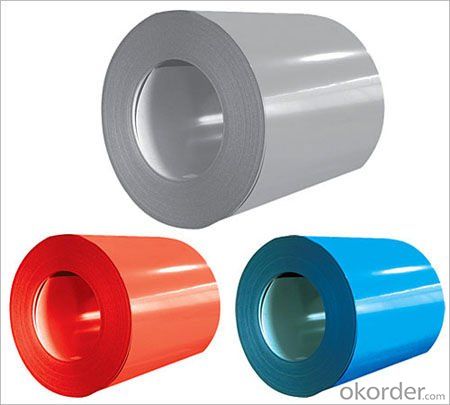
4.Pre-Painted GI/GL Steel Coil Specification
Standard: AISI, ASTM, BS, DIN, GB, JIS
Grade: DX51D, DX52D
Thickness: 0.17-2.0mm
Brand Name: KMRLON
Model Number: coil
Type: Steel Coil
Technique: Cold Rolled
Surface Treatment: Coated
Application: Boiler Plate
Special Use: High-strength Steel Plate
Width: 20-1250mm
Length: customized
commoidty: pre-painted galvanized steel coil
Thickness: 0.13-4.0mm
width: 20-1250mm
zinc coating: 40-180g/m2
printing thickness: top side: 20+/-5 microns, back side: 5-7 microns
color: all RAL color
surface treatment: color coated
coil weight: 4-7 tons
coil ID: 508/610mm
packaging: standard seaworthy packing
5.FAQ of Pre-Painted GI/GL Steel Coil
1. What’s the application of this product?
Roof, roof structure, surface sheet of balcony, frame of window, etc.
2. What’s the brand of the paint?
We use the best brand of all of the word—AKZO.
3. How to guarantee the quality of the products?
We have established the international advanced quality management system,every link from raw material to final product we have strict quality test;We resolutely put an end to unqualified products flowing into the market. At the same time, we will provide necessary follow-up service assurance.
4. How long can we receive the product after purchase?
Usually within thirty working days after receiving buyer’s advance payment or LC. We will arrange the factory manufacturing as soon as possible. The cargo readiness usually takes 15-25 days, but the shipment will depend on the vessel situation.
- Q:How are steel coils inspected for thickness using ultrasonic testing?
- Steel coils can be inspected for thickness using ultrasonic testing, which is a non-destructive testing method. In this process, a handheld ultrasonic thickness gauge is used to measure the thickness of the steel coil. The ultrasonic thickness gauge emits high-frequency sound waves that travel through the steel coil. These sound waves bounce back from the backside of the coil, creating an echo. The time taken for the echo to return to the gauge is measured and used to calculate the thickness of the coil. The gauge consists of a transducer that emits the sound waves and a receiver that detects the echoes. The transducer is placed on the surface of the coil, and a coupling gel or oil is used to ensure a good acoustic contact between the transducer and the steel surface. The transducer emits a short burst of sound waves, which penetrates through the steel coil and reaches the backside. When the sound waves encounter any changes in the thickness of the coil, such as defects or variations, they get reflected back to the transducer. The receiver detects these echoes, and the time between the emission and reception of the sound waves is measured. Using the known speed of sound in steel, the time taken for the sound waves to travel through the coil and back can be converted into a thickness measurement. This provides an accurate assessment of the thickness of the steel coil at various points. Ultrasonic testing is a reliable and efficient method for inspecting the thickness of steel coils. It allows for quick measurements without damaging the material, making it suitable for quality control and ensuring compliance with manufacturing specifications.
- Q:But we've had a problem with bears being attracted to the water in the Intex Inflatable pools, the bear would come at night every so often and push on the sides letting out the water.Would a bear be able to bend a steel frame before I go and spend money?
- depends how thick the steel is. Looking at it, I would say yes. Not the frame pieces, but just the walls of the pool.
- Q:What are the different types of steel coil grades and specifications?
- There are several different types of steel coil grades and specifications available in the market. These grades and specifications are designed to meet various industry requirements and applications. Some of the commonly used steel coil grades and specifications are: 1. Hot Rolled Steel Coils: These coils are produced by heating the steel above its recrystallization temperature and then rolling it at a high temperature. Hot rolled steel coils are commonly used in applications where dimensional accuracy and surface finish are not critical. 2. Cold Rolled Steel Coils: Cold rolled steel coils are produced by further processing hot rolled coils through cold reduction mills. This process results in improved surface finish, tighter tolerances, and higher strength compared to hot rolled coils. Cold rolled steel coils are widely used in automotive, construction, and electrical industries. 3. Galvanized Steel Coils: Galvanized steel coils are coated with a layer of zinc to protect them from corrosion. This process, known as galvanization, enhances the durability and longevity of the steel coils. Galvanized steel coils are commonly used in applications such as roofing, fencing, and automotive body parts. 4. Stainless Steel Coils: Stainless steel coils are made from a combination of iron, chromium, and other elements that provide excellent corrosion resistance and high strength. These coils are widely used in industries such as food processing, chemical, and medical, where hygiene and corrosion resistance are critical. 5. High-strength Low-alloy (HSLA) Steel Coils: HSLA steel coils are designed to have higher strength and improved formability compared to conventional carbon steels. These coils are commonly used in structural and transportation applications, where weight reduction and high strength are required. 6. Electrical Steel Coils: Electrical steel coils, also known as silicon steel or transformer steel, are specifically designed for use in electrical equipment such as transformers, motors, and generators. These coils have low core losses and high magnetic permeability, making them ideal for efficient energy transfer. 7. Tool Steel Coils: Tool steel coils are specially formulated to have high hardness, wear resistance, and toughness. These coils are commonly used in the manufacturing of cutting tools, dies, and molds. These are just a few examples of the various types of steel coil grades and specifications available in the market. The selection of the appropriate grade and specification depends on the specific application requirements, such as strength, corrosion resistance, formability, and surface finish.
- Q:for a roof spanning 14.4m x 8.4m on a residential house, is it better to use timber trusses or steel trusses? the priorities are; ease of construction, price, insulation (want to keep heat out, i am in a tropical country), durability, flexibility, minimal load on foundations.please help. thank you :-)
- U will to find details on metal trussesin constructing materials AND development through BINDRA AND ARORA and u may additionally to find them in MCKAY(B.M.C).About steel doors and windows search the net u can search in google or yahoo u will to find it . Ok bye bye all of the exceptional.
- Q:How are steel coils protected during transportation?
- Steel coils are kept safe and free from harm during transport through a range of precautionary measures. One widely used technique involves utilizing top-notch packaging materials like heavy-duty plastic wrap or waterproof paper. These materials form a protective shield against external factors such as moisture, dust, and debris. Moreover, steel coils are typically placed on wooden pallets or skids to elevate them from the ground and prevent direct contact with surfaces that may cause scratches or dents. To provide further protection, the coils are securely fastened to the pallets using strong, corrosion-resistant metal strapping or bands. This ensures that the coils remain in position and do not shift or move during transport, significantly reducing the risk of damage. Additionally, specialized equipment like coil cradles, coil racks, or coil bunks are used to load and secure the steel coils onto flatbed trailers or shipping containers. These devices are specifically designed to firmly hold the coils in place and evenly distribute their weight, preventing any stress or strain during transit. Apart from physical safeguards, steel coils may also undergo various surface treatments before being transported to prevent corrosion. This may involve applying a protective coating or oiling the coils to create a barrier between the steel and the surrounding environment. This process is particularly important when the coils are exposed to adverse weather conditions or long shipping durations, as it helps to prevent rust or other forms of corrosion. In conclusion, a combination of appropriate packaging, secure fastening, and proper loading techniques are employed to ensure the safety of steel coils during transportation. These measures guarantee that the coils arrive at their destination without significant damage.
- Q:i have searched high and low, but can't find information anywhere!bainitic and pearlitic steels are too in depth, just would like to know if it is hsla steel, or mild steel, or stainless steel etc...thank you in advance :)
- in case you have been to soften rail steel down and pour it into ingots, I doubt anybody could examine to locate this is source besides the fact that a experienced metalurgist could comprehend. whilst the steel grew to become into melted you will desire to toss a handful of previous horseshoes in and alter the composition and no you could comprehend. stable luck such as your challenge, i could decide to comprehend the way it seems.
- Q:I'm currently in an Estimating and Bidding class. I have to estimate two divisions for a multi-million dollar project. The project that I chose is around 6 million dollars and involves constructing a new gas/lighting building. I chose to estimate steel, and my question is, around how much out of the 6 million goes toward just the steel estimate? If it helps, this building is has two floors and is roughly about 100x70 feet. The building not wood construction, but rather steel and brick. How much of that 6 million would go into the steel? I'm not looking for anything exact, just roughly.
- It is not clear what stage this project is in. Is it preliminary or has a detailed design been done. It is also not clear if this is only the steel material or does it include the labor as well. A rough guess using a percentage of the total cost is okay if you have historical data to help you. If you have a detailed design then the percentage method should only be used as a check on a detailed cost estimate developed from the plans. If you plan to use numbers provided by someone here on Answers I would hardly call that an estimate.
- Q:How are steel coils inspected for surface finish?
- Steel coils are inspected for surface finish through a visual examination by trained inspectors. They carefully inspect the coils for any defects, such as scratches, pits, or uneven surfaces. Additionally, specialized equipment like optical scanners or digital cameras may be used to capture high-resolution images for a more detailed analysis. The goal is to ensure that the surface finish of the steel coils meets the required standards and is free from any imperfections that could affect its quality or performance.
- Q:What are the different types of steel coil handling attachments?
- There are several different types of steel coil handling attachments that are commonly used in industrial settings. These attachments are designed to safely and efficiently handle steel coils of various sizes and weights. One type of steel coil handling attachment is the coil lifter. This attachment is typically made of durable steel and is designed to securely grip the steel coil. It features a set of adjustable arms or hooks that can be positioned to fit the specific size and shape of the coil. Coil lifters are often used in conjunction with cranes or other lifting equipment to safely transport steel coils. Another common type of attachment is the coil grab. Similar to a coil lifter, a coil grab is used to securely grip and lift steel coils. However, coil grabs often feature a more compact design and are typically used in applications where space is limited. They can be operated manually or attached to a crane or forklift. Additionally, there are coil tongs that are specifically designed to handle smaller steel coils. These tongs are often used in manufacturing or processing facilities where coils need to be lifted and moved within a confined space. Coil tongs typically feature a set of adjustable jaws that can be positioned to grip the coil securely. In some cases, magnetic attachments are used to handle steel coils. These magnets are designed to attract and hold onto the steel, allowing for easy lifting and transportation. Magnetic attachments are often used in applications where other types of attachments may not be suitable, such as in environments with extreme temperatures or where the steel coils are coated. It is important to note that the specific type of steel coil handling attachment used will depend on the size and weight of the coils, as well as the specific requirements of the application. Industrial equipment suppliers can provide guidance on selecting the most appropriate attachment for a particular situation.
- Q:What are the common challenges faced in steel coil production?
- Some common challenges faced in steel coil production include ensuring consistent quality and dimensional accuracy, managing the high energy consumption involved in the production process, handling and transporting heavy coils safely, and minimizing the risk of surface defects and damage during processing and storage. Additionally, maintaining efficient production speeds, optimizing material utilization, and meeting customer demands for timely delivery can also pose challenges in steel coil production.
1. Manufacturer Overview |
|
|---|---|
| Location | |
| Year Established | |
| Annual Output Value | |
| Main Markets | |
| Company Certifications | |
2. Manufacturer Certificates |
|
|---|---|
| a) Certification Name | |
| Range | |
| Reference | |
| Validity Period | |
3. Manufacturer Capability |
|
|---|---|
| a)Trade Capacity | |
| Nearest Port | |
| Export Percentage | |
| No.of Employees in Trade Department | |
| Language Spoken: | |
| b)Factory Information | |
| Factory Size: | |
| No. of Production Lines | |
| Contract Manufacturing | |
| Product Price Range | |
Send your message to us
Pre-Painted Galvanized Steel---Brick Red
- Loading Port:
- Tianjin
- Payment Terms:
- TT OR LC
- Min Order Qty:
- 100 m.t.
- Supply Capability:
- 10000 m.t./month
OKorder Service Pledge
OKorder Financial Service
Similar products
Hot products
Hot Searches
Related keywords
